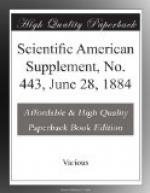[Illustration: GENERAL VIEW OF A LABORATORY AT THE PARIS SCHOOL OF PHYSICS AND CHEMISTRY.]
The pupils occupy themselves regularly every day, during half the time spent at the school, with practical work in analytical and applied chemistry and physics and general chemistry. This practical work is a complement to the various lectures, and has reference to what has been taught therein. Once or twice per week the pupils spend three hours in a shop devoted to wood and metal working, and learn how to turn, forge, file, adjust, etc.
The school’s cabinets are now provided with the best instruments for study, and are daily becoming richer therein. The chemical laboratories are none the less remarkably organized. In the accompanying cut we give a view of one of these—the one that is under the direction of Mr. Schultzenberger, professor of chemistry and director of the new school. Each pupil has his own place in front of a large table provided with a stand whereon he may arrange all the products that he has to employ. Beneath the work-table he has at his disposal a closet in which to place his apparatus after he is through using them. Each pupil has in front of him a water-faucet, which is fixed to a vertical column and placed over a sink. Alongside of this faucet there is a double gas burner, which may be connected with furnaces and heating apparatus by means of rubber tubing. A special hall, with draught and ventilation, is set apart for precipitations by sulphureted hydrogen and the preparation of chlorine and other ill-smelling and deleterious gases. The great amount of light and space provided secure the best of conditions of hygiene to this fine and vast laboratory, where young people have all the necessary requisites for becoming true chemists.—La Nature.
* * * * *
DUST-FREE SPACES.[1]
[Footnote 1: Lecture to the
Royal Dublin Society by Dr. Oliver J.
Lodge, April 2, 1884.]
Within the last few years a singular interest has arisen in the subject of dust, smoke, and fog, and several scientific researches into the nature and properties of these phenomena have been recently conducted. It so happened that at the time I received a request from the secretary of this society to lecture here this afternoon I was in the middle of a research connected with dust, which I had been carrying on for some months in conjunction with Mr. J.W. Clark, Demonstrator of Physics in University College, Liverpool, and which had led us to some interesting results. It struck me that possibly some sort of account of this investigation might not be unacceptable to a learned body such as this, and accordingly I telegraphed off to Mr. Moss the title of this afternoon’s lecture. But now that the time has come for me to approach the subject before you, I find myself conscious of some misgivings, and the misgivings are founded upon this




